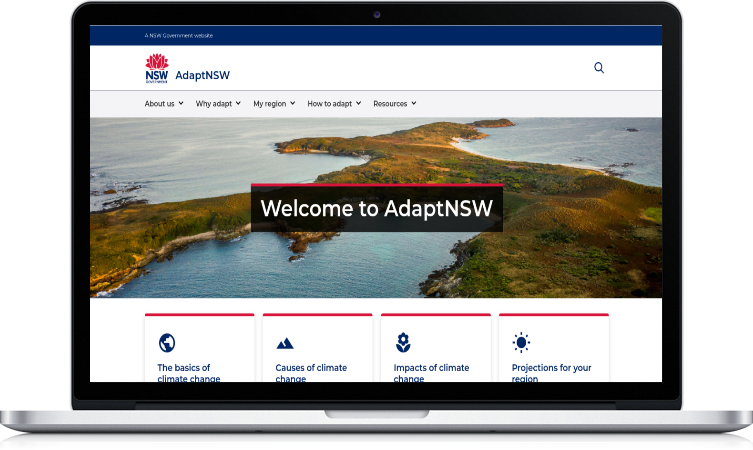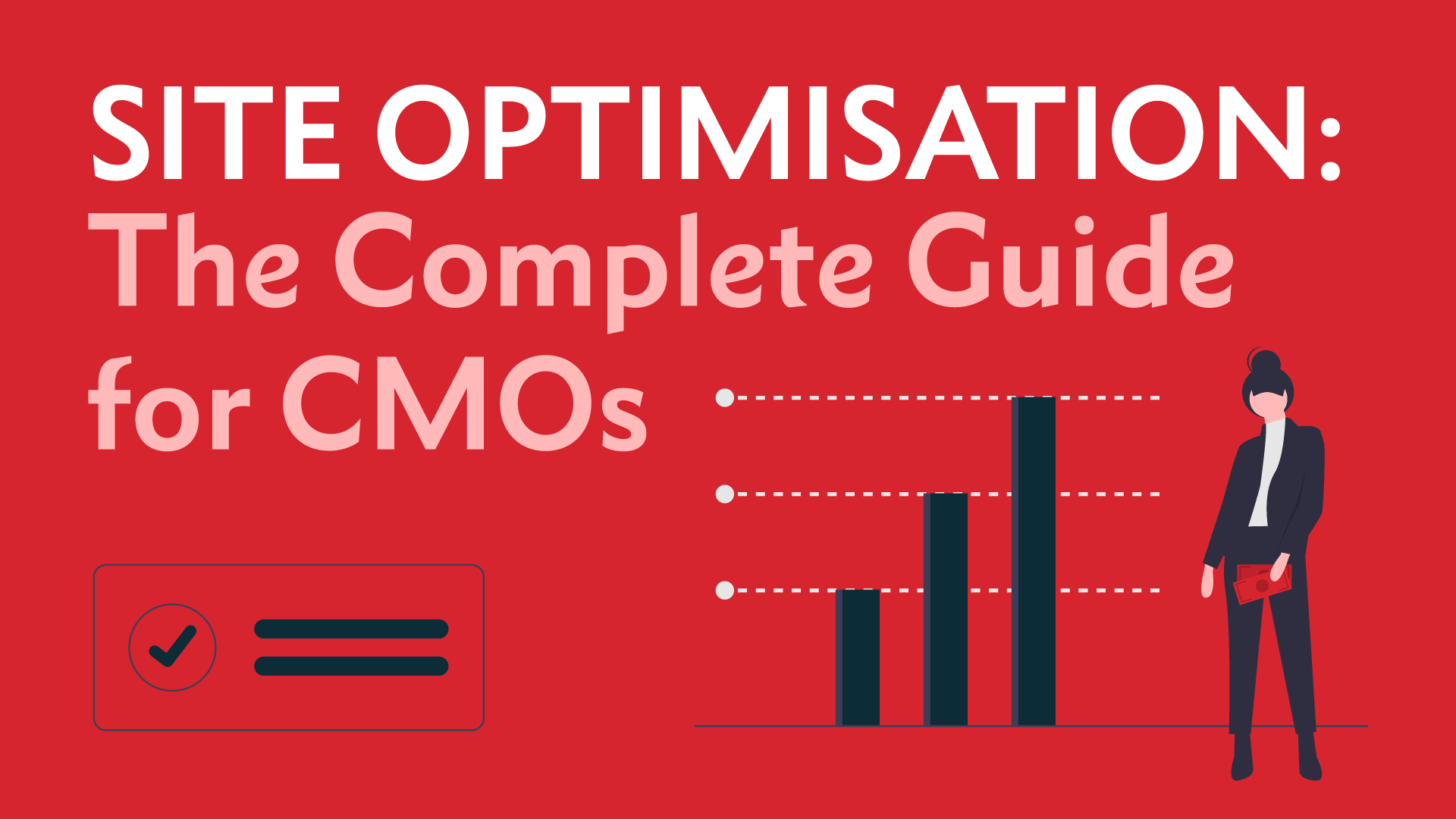Creating the leading source of climate change information with AdaptNSW

AdaptNSW is the leading source of credible information on climate change for NSW, produced by the Office of Energy and Climate Change, New South Wales Treasury (OECC). The site’s stated goal is to ‘inform and empower communities, businesses, households and government to adapt to climate change’, providing a valuable resource at a time when it is most needed.
The Challenge
The former AdaptNSW website was visually and technically dated, and both its information and organisation failed to meet the needs of the diverse stakeholder groups using it to seek information on climate change.
In addition to improving usability for all visitors, OECC aimed to bring the site in-line with NSW government design standards, achieve compliance with the WCAG 2.1 AA accessibility standard, introduce interactive data interpretation features, improve overall site performance, and streamline content authoring workflows.
The Outcome
Following Sitback’s deployment of the new AdaptNSW website, total visitors to the site have increased by 51%. Further, a 22% increase in average time-on-page suggests that users are now better able to navigate and engage with the site’s content.
Yet the full impact of the new site’s launch can’t be measured in numbers alone. As climate change increasingly impacts our lives, resources like AdaptNSW will play a critical role in driving behavioural change by encouraging citizens to take positive action whilst adapting to changes that are already occurring in our world.
The AdaptNSW website has since been recognised as a finalist in the "Building A Better Tomorrow" category of the Acquia Engage Awards 2022.
Project Background
Nearly eight years had passed since the launch of the previous AdaptNSW website—and it was clearly due for a refresh. “The purpose of the old website was unclear,” describes Aaron Coutts-Smith, Senior Team Leader, Net Zero Implementation at OECC. “There were no clear handoffs that said, ‘go here to do this’. The layout wasn't that useful—it was just unclear what people would actually get out of the site.”
Misconceptions about the types of visitors that would be accessing the site contributed to this lack of clarity. “When the website was first designed, it was designed around the delivery of climate change projections and data, and it focussed on a fairly narrow customer audience of practitioners,” he notes.
However, as the OECC team reviewed its historical web analytics, it became clear that the site’s actual usage deviated from this vision. According to Coutts-Smith, “We learned that the people who were coming to the website were after some basic information about climate change, which tells us that the audiences’ needs were probably going unmet. That was a clear gap for us—we needed to send them through the journey on the website to information on how to tangibly respond and act.”
OECC was also conscious that not all of its visitors would be staunch environmentalists, and that the information shared needed to serve as many of NSW’s 8.2 million residents as possible. “Not everybody is interested in the environment,” Coutts-Smith continues. “We know that the impacts of climate change are far broader than the environment, affecting people directly through their health, the things they value, and the places they go.”
“We wanted to be able to make the link for people between these fairly high-level ideas so that they can have a tangible understanding of how climate change will impact them.”
Not everybody is interested in the environment. We know that the impacts of climate change are far broader than the environment, affecting people directly through their health, the things they value, and the places they go.
We wanted to be able to make the link for people between these fairly high-level ideas so that they can have a tangible understanding of how climate change will impact them.”
- Aaron Coutts-Smith, Senior Team Leader, Net Zero Implementation at OECC

Our Solution
Before initiating the restructuring of its AdaptNSW website, OECC had already undertaken a number of planning exercises to align internally on its target user personas and user journeys. “We initially started with a task-orientated breakdown of the architecture, but then it transitioned to more of a sector-based approach,” according to Coutts-Smith.
From this work, OECC identified four key user personas: the procrastinator, the hunter-gatherer, the problem-solver, and the torch-bearer. The agency also worked with Deloitte to prepare initial UX design mockups to better understand how the reimagined site might support these distinct groups.
By November 2020, OECC was ready to move into the redevelopment phase and identified Sitback as a perfect partner, thanks to a referral from the digital team at the NSW Government Digital Information Office (DIO).
“There are a lot of things that were dictated to us, including the use of Drupal, Acquia, and the NSW Government Digital Design System,” Coutts-Smith notes. While Sitback was already a pre-approved government vendor, “we were taking advice from the DIO around who would be good at this type of work, and they came up with Sitback, based on other work that they'd been doing.”
OECC initially asked for a reverse brief to understand Sitback’s approach to the project. “We were really happy with what came through,” states Stephen Alessi, Project Officer at OECC. “Throughout that selection process, it was clear that Sitback met our needs.”
A Multipronged Approach
In addition to restructuring the information and organisation of its website, OECC also hoped to address the site’s accessibility and usability for both internal and external users. To deliver against these and other objectives, Sitback undertook a multipronged approach to the new site’s development.
Accessibility & Efficiency
One of Sitback’s first priorities was to bring the new AdaptNSW site into alignment with both the NSW Government Digital Design System (DDS)—a toolkit of patterns and components used to streamline the building of digital services for creators in NSW Government—and the WCAG 2.1 AA accessibility standard.
“We did have to do some rework on the Deloitte designs to bring them in-line with the New South Wales Design System,” explains Leigh Wood, Senior Project Manager at Sitback. Further, he notes, “While the DDS provided us with base HTML, JavaScript, and CSS to utilise, the Drupal system puts out a lot of superfluous HTML markup. We had to ensure that the code we wrote was being properly presented according to the DDS—and in situations where Drupal couldn't get it exactly right, we had to write additional hooks and CSS to bring the application in line.”
Sitback’s developers brought this same detail-orientated view to the customisation of the new AdaptNSW content management system (CMS). Because OECC was using the redevelopment process to transition from Sitecore CMS to the Drupal platform, Sitback looked for opportunities to leverage contributed modules within the newly created content workflows.
“We went for the Paragraphs approach, which allows you to add in components—which are templated—at their own levels,” explains Wood, referring to Drupal’s contributed module, Paragraphs. “Each component has its own template that gets pulled into the system. This makes for a very flexible content structure because it allows any content within the site to be easily created and differentiated from one another.”
“Using contributed modules such as Paragraphs, where they were available, saved time and provides OECC with the support of the development community, as opposed to writing them completely ourselves,” he states. Additional updates were made to the AdaptNSW Drupal admin interface and its default layout structure to improve ease of use for the OECC team, while in-built automations will save time on future deployments.
For instance, by utilising Pipeline scripts, Sitback’s developers were able to automate deployment between the site’s Bitbucket code repository and its live Acquia environment. As a result, testing and deployment processes that used to require 15-45 minutes and multiple steps can now be completed with a simple code push.
Interactive Climate Mapping
As a part of its tender, OECC specifically requested the development of an interactive mapping technology that would allow site visitors to engage dynamically with the agency’s climate change datasets. Because no existing libraries provided the full functionality or accessibility OECC required, Sitback engaged in a full custom build to deliver an interactive climate change projections map.  “The map is really intuitive,” says Nathan Feick, Development Team Lead at Sitback. “It's very clever in the way it uses multiple datasets to show the different climate trends across New South Wales. It's interactive in the fact that you can select the different regions, and as visitors change their selections, everything updates within the map.”
“The map is really intuitive,” says Nathan Feick, Development Team Lead at Sitback. “It's very clever in the way it uses multiple datasets to show the different climate trends across New South Wales. It's interactive in the fact that you can select the different regions, and as visitors change their selections, everything updates within the map.”
Carl Brown, Sitback’s Interactive Experience Director, adds that, “The AdaptNSW custom climate map really demonstrates Sitback’s ability to create innovative solutions that can pull the signal from the noise by taking in different data points and doing something useful with them.”
User experience was of particular concern as Sitback built out the map’s whisker graphing capabilities. According to Feick, “There is a lot of data available, but you don’t leave the page when you change its configuration—you’re not being taken off, waiting for the page to load. We took that into account when developing it this way so that the load time for users is reduced to a minimum.”
Feick also highlights an innovative feature contributing to the map’s shareability—an important consideration given OECC’s goal of driving behavioural change. “We allowed the ability to pre-populate a lot of these selections, and captured that in the URL. It’s not just a standard page share—you can actually share a specific configuration,” he notes. In particular, OECC expect to utilise this type of sharing in academic and research settings, as well as in agency communications.
A Foundation for Future Sites
Throughout the project’s development, Sitback worked closely with OECC’s team via Basecamp to complete initiatives and implement best practices. A few of the specific steps taken by Sitback’s developers to enhance visitors’ experience on the new AdaptNSW website include:
- Utilising content caching to improve overall site speed and performance.
- Ensuring all site code was written in an efficient, dynamic way that allows for reuse without hard-coding in values.
- Incorporating Drupal contributed modules where available, rather than writing new modules ourselves to save time, reduce cost, and allow for the support of the development community.
- Ensuring code is only called when needed, such as by consolidating JavaScript and CSS to require fewer requests on the server.
These and other actions were so successful that, following the site’s launch, the NSW Department of Planning and Environment (DPE) have white-labelled the AdaptNSW build and are currently using it as the base setup for other new governmental sites.
Changing Behaviour for Good
Since the launch of the new AdaptNSW website, OECC have already seen improvements in a number of key engagement metrics. Comparing a baseline measurement period of 1 Feb 2021 to 30 June 2021 to the first five months of its operation (from 1 Feb 2022 to 30 June 2022), the new site has driven:
- A 51% increase in total users.
- A 21% increase in page views.
- A 22% increase in average time on page.
- Increased downloads of the agency’s ‘Climate Risk Ready Guide’ and related tools.
The implementation of three site libraries has also granted OECC the ability to better understand user preferences. Because OECC can now integrate their newsletter and website resources, the agency can use click tracking to gauge which stories are particularly interesting to readers. Over time, OECC’s ability to use these insights to create more targeted content is likely to translate to even better visitor experiences.
“In some areas of the website, we went out with what we might call ‘minimum viable content’,” explains Coutts-Smith. “We couldn't have it all done at the same time, so we've sort of leaned into that and are releasing new content continually as campaigns. With this continual, ongoing rhythm of introducing improvements that target different cohorts, we can then promote that we've got updated content for visitors to come to the website and see what's new.”
“In some areas of the website, we went out with what we might call ‘minimum viable content’. We couldn't have it all done at the same time, so we've sort of leaned into that and are releasing new content continually as campaigns.
With this continual, ongoing rhythm of introducing improvements that target different cohorts, we can then promote that we've got updated content for visitors to come to the website and see what's new.”
- Aaron Coutts-Smith, Senior Team Leader, Net Zero Implementation at OECC
The new site’s streamlined publishing workflows have also made it easier for OECC to respond to elevated interest in climate change content whenever natural disasters, such as floods, fires, and extreme weather occur.
According to Alessi, “One of the advantages of shifting to the new website was creating opportunities to be more spontaneous in that respect—to be able to lift specific content to the front page that was very topical. Being able to connect people more quickly with the information that is relevant at the time is definitely a benefit of the new site.”

Looking to the Future
As we enter a new era of climate science and adaptation communication in NSW, Sitback is excited to continue its partnership with the OECC team by providing ongoing support and optimisation services for the AdaptNSW website.
Since the site’s launch, for example, Sitback has led the deployment of a filterable research and resources section to house specialist science reports. Future planned improvements include the development of NSW and Australian Regional Climate Modelling (NARCliM) communications products that will work with the OECC Climate Data Portal to boost climate literacy across state and local governments.
“The team at Sitback are particularly proud of the role we played in supporting OECC’s vision, as the mission of AdaptNSW aligns closely with our own organisational values and current BCORP initiative,” Brown concludes. “With climate change impacting our lives, it is vital that we take positive action while adapting to the changes that are already occurring in our world. We see the new AdaptNSW website as providing critical education that encourages this evolution.”

